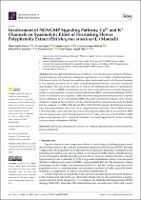Por favor, use este identificador para citar o enlazar este ítem:
https://repositorio.usj.es/handle/123456789/1008
| Título : | Involvement of NO/cGMP Signaling Pathway, Ca2+ and K+ Channels on Spasmolytic Effect of Everlasting Flower Polyphenolic Extract (Helichrysum stoechas (L.) Moench) |
| Autor: | Valero Gracia, Marta Sofía



López Ramos, Víctor 

Castro, Marta 


Gómez-Rincón, Carlota 

Arruebo, María Pilar 


Les Parellada, Francisco 

Plaza, Miguel Ángel 

|
| Palabras clave : | Antioxidant; Antispasmodic activity; Ion channels; Gastrointestinal diseases; Medicinal plants; Polyphenols |
| Fecha de publicación: | 20-nov-2022 |
| Editorial : | MDPI |
| Citación : | Valero, M.S.; López, V.; Castro, M.; Gómez-Rincón, C.; Arruebo, M.P.; Les, F.; Plaza, M.Á. Involvement of NO/cGMP Signaling Pathway, Ca2+ and K+ Channels on Spasmolytic Effect of Everlasting Flower Polyphenolic Extract (Helichrysum stoechas (L.) Moench). Int. J. Mol. Sci. 2022, 23, 14422. https://doi.org/10.3390/ ijms232214422 |
| Resumen : | Functional gastrointestinal diseases (FGID) are worldwide prevalent conditions. Pharmacological treatments can be ineffective, leading the population to turn to herbal or traditional remedies. Helichrysum stoechas (L.) Moench is a medicinal plant traditionally used in the Iberian Peninsula to treat digestive disorders, but its effects on gastrointestinal motility have not been scientifically demonstrated. The aim of this work was to evaluate the antispasmodic effect of a polyphenolic extract of H. stoechas (HSM), its mechanism of action and its antioxidant activity. Isometric myography studies were performed in rat ileum, and malondialdehyde (MDA) and 4-hydroxyalkenals (4-HDA) levels were measured in rat jejunum. HSM reduced the integrated mechanical activity of spontaneous contractions. In Ca2+-free medium, HSM reduced the concentration–response curve of CaCl2 similarly to verapamil. Pre-incubation with the extract blocked the contraction induced by Bay K8644, KCl and carbachol. L-NAME, ODQ, Rp-8-Br-PET-cGMPS, KT-5823, apamin, TRAM-34 and charybdotoxin reduced the relaxant effect of the extract on spontaneous contractions. MDA+4-HDA levels in LPS-treated tissue were reduced by the extract, showing antioxidant activity. In conclusion, HSM showed antispasmodic activity through inhibition of Ca2+ influx, activation of the NO/PKG/cGMP pathway and opening of Ca2+-activated K+ channels. The results suggest that H. stoechas could help in the prevention or treatment of FGIDs. |
| URI : | https://repositorio.usj.es/handle/123456789/1008 |
| ISSN : | 1422-0067 |
| Aparece en las colecciones: | Artículos de revistas |
Ficheros en este ítem:
| Fichero | Descripción | Tamaño | Formato | |
|---|---|---|---|---|
| Involvement of.pdf | 1,49 MB | Adobe PDF |  Visualizar/Abrir |
Este ítem está sujeto a una licencia Creative Commons Licencia Creative Commons

